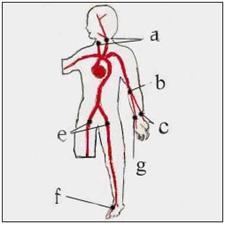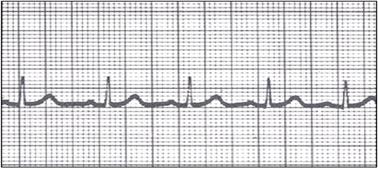정상 맥박, 정상 심장 박동(정상 심박수), Normal pulses, normal heart rate in children(0~16 year old)

그림 2-109. 남색 점으로 표시된 신체부위에서 맥박을 잴 수 있다.
신생아기 이후 a-경동맥, b-팔 동맥, c-요골 동맥, d-대퇴 동맥 등에서 맥박을 잴 수 있다. 앞가슴 중앙의 부위에서 심장박동을 잴 수 있고 발등 동맥에서도 맥박을 잴 수 있다.
Copyright ⓒ 2011 John Sangwon Lee, MD., FAAP

그림 2-110. 맥박을 짚고 잴 수 있는 신체의 부위
a-경동맥, b-상완 동맥, c-요골 동맥, e-대퇴 동맥 f-발등 동맥, g-척골 동맥, 신생아들이나 영유아들의 맥박을 짚거나 잴 때 요골 동맥, 척골 동맥, 발등 동맥을 짚어 보고 거기서 맥박 재는 것은 그렇게 쉽지 않다. 그래서 경동맥, 상완 동맥, 대퇴 동맥을 짚어 재든지 청진기로 심장 박동을 재는 것이 보통이다.
Copyright ⓒ 2011 John Sangwon Lee, MD., FAAP

그림2-111.심장자극 전도
심장자극 전도가 동방 결절에서 시작돼서 방실계 결절로 전도되고 그 다음에는 좌심실과 우심실이 있는 심장자극 전도계로 퍼져 정상적으로 심방과 심실이 수축되고 이완될 때 생기는 심장박동을 정상 심박이라고 한다.
a-좌심방, b-심장자극 전도, c-좌심실, d-우심실, e-방실계 결절, f-우심방, g-동방결절
Copyright ⓒ 2011 John Sangwon Lee, MD., FAAP
- 맥박 수치와 심장 박동 수치는 동일한 것이 정상이다.
- 맥박 수치는 나이, 체온, 수면, 운동, 감정 변화 등에 따라 시시각각으로 다소 변하는 것이 정상이다.
- 특히 진찰을 받을 때, 수줍어하거나 두려워하거나 놀랠 때 대부분의 아이들의 심장이 정상적으로 더 빠르게 뛴다.
- 건강한 사춘기 아이들의 맥박은 정상적으로 느릴 수 있다. 정상적으로 생긴 동성 서맥은 정상적이고 아무 증상징후가 없는 것이 정상이다.
표 2-5. 소아들의 정상 심장 박동 수(맥박 수)
| 나이 | 평균 심장 박동수 | 심장 박동수 범위 |
| 0~24시간 | 145 | 80~200 |
| 1~7일 | 138 | 100~188 |
| 8~30일 | 162 | 125~188 |
| 1~3개월 | 161 | 115~215 |
| 3~6개월 | 149 | 100~215 |
| 6~12개월 | 147 | 100~188 |
| 1~3세 | 130 | 80~188 |
| 3~5세 | 105 | 68~150 |
| 5~8세 | 102 | 75~150 |
| 1~12세 | 88 | 51~125 |
| 12~16세 | 83 | 38~125 |
참조문헌; 6th edition, P.59. The Harriet Lane Handbook Growth and Development of Children, George H. Lowrey 8th edition, p.246 Nelson text book, 15 edition 그 외
- 소아들의 맥박은 신체 표면 즉 피부층에 가까이 있는 동맥을 손가락 끝으로 짚어 잴 수 있다.
- 아주 어린 영유아들의 맥박은
-
- 목에 있는 경동맥,
- 서혜부에 있는 대퇴동맥이나
- 팔꿈치 앞쪽에 있는 상완동맥이나
- 손목에 있는 요골동맥에서 재든지,
- 맥박을 재는 대신 심장음을 들어 보고 심장 박동수에 따라 맥박 수를 간접적으로 재는 경우도 있다.
- 영유아기 이후의 아이들의 맥박은 아주 어린 유아들의 맥박을 잴 때와 거의 같게 재든지, 성인의 맥박을 잴 때처럼 손목에 있는 요골동맥에서 잴 수 있다.
- 아이들의 심장 박동수(맥박수)는 감정이나 주위의 자극 등에 따라 쉽게 영향 받기 때문에 시시각각으로 다소 변화될 수 있다.
- 심장박동은 깨어 있을 때보다 잠들어 자는 동안은 감정의 변화나 주위의 변화로 덜 자극 받고덜 영향 받기 때문에 잠들어 자는 동안 맥박수나 심장 박동수를 재어 알아보는 것이 임상적으로 더 많은 가치가 있다(p.00 신생아의 맥박 참조).
- 부모가 어떤 이유로 집에서 신생아나 영유아들의 맥박이나 심장 박동수를 재보고 정상인지를 알아본다는 것은 쉬운 일은 아니다.
- 그렇지만 부모도가 어린 신생아들, 영유아들의 맥박을 한두 시간 간격으로 몇 번 반복 쟀을 때 맥박이 상당히 빠르거나 비정상적으로 느리거나 맥박이 불규칙하게 뛰는 것 같으면 의사에게 곧 문의해야 한다.

그림2-112.정상 심전도(정상 심장 전도)
맥박을 재는 대신 심전도 검사를 해서 심장 박동수를 알아 볼 수도 있다.

그림 2-113. 정상 심장 전도
a-동성 부정맥, b-동성 빈맥, c-동성 서맥. Copyright ⓒ 2011 John Sangwon Lee, MD., FAAP
Normal pulses, normal heart rate in children (0~16 year old) 정상 맥박, 정상 심장 박동(정상 심박수)

Figure 2-109. You can measure a newborn’s pulse on the part of the body marked with a blue dot. After the neonatal period, pulses can be measured in the a-carotid artery, b-brachial artery, c-radial artery, and d-femoral artery. You can measure your newborn’s heart rate in the center of the anterior chest, and you can also measure your newborn’s pulse in the carotid artery, brachial artery, femoral artery usually. Copyright ⓒ 2011 John Sangwon Lee, MD., FAAP

Figure 2-110. The part of the body where you can measure and measure your pulse a-carotid artery, b-brachial artery, c-radial artery, e-femoral artery, f-instep artery, g-ulnar artery, when measuring or measuring the pulse of newborns or infants, point to the radial artery, ulnar artery, and instep radial artery. Measuring your newborn’s pulse isn’t that easy. Therefore, it is common to measure the carotid artery, the brachial artery, and the femoral artery, or measure the heart rate with a stethoscope. Copyright ⓒ 2011 John Sangwon Lee, MD., FAAP

Figure 2-111. Heart stimulation conduction.
The heartbeat occurs when the heart stimulus conduction begins in the Sinus node, conducts to the atrioventricular node, and then spreads to the cardiac stimulus conduction system with the left and right ventricles, and the atrium and ventricle are normally contracted and relaxed is called the normal heartbeat. a-left atrium, b-cardiac stimulation conduction, c-left ventricle, d-right ventricle, e-atrioventricular node, f-right atrium, g-sinus node. Copyright ⓒ 2011 John Sangwon Lee, MD., FAAP
- It is normal for the pulse and heart rate to be the same.
- It is normal for the pulse level to change slightly from moment to moment depending on age, body temperature, sleep, exercise, and emotional changes. Most children’s hearts beat normally faster, especially when they see a doctor, when they are shy, afraid or surprised. In healthy adolescent children, the pulse can be normally slow. It is normal to have a normal sinus bradycardia and no symptoms.
Table 2-5. Children’s normal heart rate (pulse rate) 표 2-5. 소아들의 정상 심장 박동 수(맥박 수)
| Age | Average Heart Rate | Heart Rate Range |
| 0~24 hour | 145 | 80~200 |
| 1~7 day | 138 | 100~188 |
| 8~30 day | 162 | 125~188 |
| 1~3 month | 161 | 115~215 |
| 3~6 month | 149 | 100~215 |
| 6~12 month | 147 | 100~188 |
| 1~3 year | 130 | 80~188 |
| 3~5 year | 105 | 68~150 |
| 5~8 year | 102 | 75~150 |
| 1~12 year | 88 | 51~125 |
| 12~16 year | 83 | 38~125 |
References; 6th edition, P.59. The Harriet Lane Handbook Growth and Development of Children, George H. Lowrey 8th edition, p.246 Nelson textbook, 15 edition and other
- Children’s pulse can be measured with a fingertip on the surface of the body, an artery close to the skin layer.
- The pulse of very young infants and toddlers
1. Carotid artery in the neck,
2. The femoral artery in the groin
3. The brachial artery in front of the elbow
4. Whether it is measured in the radial artery in the wrist,
5. In some cases, instead of measuring the pulse, listen to the heartbeat
and measure the pulse rate indirectly depending on the heart rate.
- The pulses of children after infancy can be measured almost the same as the pulses of very young infants, or from the radial artery of the wrist, just like adult pulses. Because children’s heart rate (pulse rate) is easily affected by emotions or stimuli around them,
- it can change slightly from moment to moment.
- Since the heart rate is less stimulated and less affected by emotional or surrounding changes during sleep than when awake, it is clinically more valuable to measure the pulse rate or heart rate while sleeping (Newborn’s pulse).
- It is not easy for parents to check the pulse or heart rate of a newborn or infant at home for some reason to see if it is normal.
- However, if a parent has a very fast, abnormally slow, or erratic pulse when measuring the pulses of young newborns and infants several times at intervals of an hour or two, contact a doctor immediately.

- Figure 2-112. Normal ECG (normal heart conduction). Instead of measuring your newborn’s pulse, you can also do an electrocardiogram to check your heart rate.

Figure 2-113. Normal heart conduction. a-sinus arrhythmia, b-sinus tachycardia, c-sinus bradycardia. Copyright ⓒ 2011 John Sangwon Lee, MD., FAAP
출처 및 참조 문헌
- NelsonTextbook of Pediatrics 22ND Ed
- The Harriet Lane Handbook 22ND Ed
- Growth and development of the children
- Red Book 32nd Ed 2021-2024
- Neonatal Resuscitation, American Academy Pediatrics
- www.drleepediatrics.com 제1권 소아청소년 응급 의료
- www.drleepediatrics.com 제2권 소아청소년 예방
- www.drleepediatrics.com 제3권 소아청소년 성장 발육 육아
- www.drleepediatrics.com 제4권 모유,모유수유, 이유
- www.drleepediatrics.com 제5권 인공영양, 우유, 이유식, 비타민, 미네랄, 단백질, 탄수화물, 지방
- www.drleepediatrics.com 제6권 신생아 성장 발육 육아 질병
- www.drleepediatrics.com제7권 소아청소년 감염병
- www.drleepediatrics.com제8권 소아청소년 호흡기 질환
- www.drleepediatrics.com제9권 소아청소년 소화기 질환
- www.drleepediatrics.com제10권. 소아청소년 신장 비뇨 생식기 질환
- www.drleepediatrics.com제11권. 소아청소년 심장 혈관계 질환
- www.drleepediatrics.com제12권. 소아청소년 신경 정신 질환, 행동 수면 문제
- www.drleepediatrics.com제13권. 소아청소년 혈액, 림프, 종양 질환
- www.drleepediatrics.com제14권. 소아청소년 내분비, 유전, 염색체, 대사, 희귀병
- www.drleepediatrics.com제15권. 소아청소년 알레르기, 자가 면역질환
- www.drleepediatrics.com제16권. 소아청소년 정형외과 질환
- www.drleepediatrics.com제17권. 소아청소년 피부 질환
- www.drleepediatrics.com제18권. 소아청소년 이비인후(귀 코 인두 후두) 질환
- www.drleepediatrics.com제19권. 소아청소년 안과 (눈)질환
- www.drleepediatrics.com 제20권 소아청소년 이 (치아)질환
- www.drleepediatrics.com 제21권 소아청소년 가정 학교 간호
- www.drleepediatrics.com 제22권 아들 딸 이렇게 사랑해 키우세요
- www.drleepediatrics.com 제23권 사춘기 아이들의 성장 발육 질병
- www.drleepediatrics.com 제24권 소아청소년 성교육
- www.drleepediatrics.com 제25권 임신, 분만, 출산, 신생아 돌보기
- Red book 29th-31st edition 2021
- Nelson Text Book of Pediatrics 19th- 21st Edition
- The Johns Hopkins Hospital, The Harriet Lane Handbook, 22nd edition
- 응급환자관리 정담미디어
- Pediatric Nutritional Handbook American Academy of Pediatrics
- 소아가정간호백과–부모도 반의사가 되어야 한다, 이상원 저
- The pregnancy Bible. By Joan stone, MD. Keith Eddleman, MD
- Neonatology Jeffrey J. Pomerance, C. Joan Richardson
- Preparation for Birth. Beverly Savage and Dianna Smith
- 임신에서 신생아 돌보기까지. 이상원
- Breastfeeding. by Ruth Lawrence and Robert Lawrence
- Sources and references on Growth, Development, Cares, and Diseases of Newborn Infants
- Emergency Medical Service for Children, By Ross Lab. May 1989. p.10
- Emergency care, Harvey Grant and Robert Murray
- Emergency Care Transportation of Sick and Injured American Academy of Orthopaedic Surgeons
- Emergency Pediatrics A Guide to Ambulatory Care, Roger M. Barkin, Peter Rosen
- Quick Reference To Pediatric Emergencies, Delmer J. Pascoe, M.D., Moses Grossman, M.D. with 26 contributors
- Neonatal resuscitation Ameican academy of pediatrics
- Pediatric Nutritional Handbook American Academy of Pediatrics
- Pediatric Resuscitation Pediatric Clinics of North America, Stephen M. Schexnayder, M.D.
-
Pediatric Critical Care, Pediatric Clinics of North America, James P. Orlowski, M.D.
-
Preparation for Birth. Beverly Savage and Dianna Smith
-
Infectious disease of children, Saul Krugman, Samuel L Katz, Ann A.
- 제4권 모유, 모유수유, 이유 참조문헌 및 출처
- 제5권 인공영양, 우유, 이유, 비타민, 단백질, 지방 탄수 화물 참조문헌 및 출처
- 제6권 신생아 성장발육 양호 질병 참조문헌 및 출처
- 소아과학 대한교과서
-
RCopyright ⓒ 2015 John Sangwon Lee, MD., FAAP
미국 소아과 전문의, 한국 소아청소년과 전문의 이상원 저 “부모도 반의사가 되어야 한다”-내용은 여러분들의 의사로부터 얻은 정보와 진료를 대신할 수 없습니다.
“The information contained in this publication should not be used as a substitute for the medical care and advice of your doctor. There may be variations in treatment that your doctor may recommend based on individual facts and circumstances. “Parental education is the best medicine.”